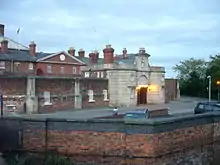HM Prison Stafford
HM Prison Stafford is a Category C men's prison, located in Stafford, Staffordshire, England. The prison is operated by Her Majesty's Prison Service. In 2014 it became a sex offender-only jail.[1]
 | |

| |
| Location | Stafford, Staffordshire |
|---|---|
| Security class | Adult Male/Category C |
| Population | 741 (as of May 2009) |
| Opened | 1793 |
| Managed by | HM Prison Services |
| Governor | Ralph Lubkowski |
| Website | Stafford at justice.gov.uk |
History
Her Majesty's Prison at Stafford was originally constructed and opened in 1793. It was substantially enlarged by a building development programme of works in the 19th Century.[2]
Early history
In 1812, forger William Booth was publicly executed outside the jail. A badly-tied rope allowed him to fall to the floor, unharmed. He was hanged a second time, fatally, later that day.[3]
Among its early prisoners was George Smith, who served several sentences for theft in the facility and began his later work as a hangman while still a prisoner, assisting William Calcraft.[4] He officiated at several executions in the prison later in his life, including that of the convicted poisoner William Palmer in 1866.
Prisoner of War facility 1916
H.M.P. Stafford was used to incarcerate prisoners of war from the defeated Easter Rising in April 1916.[5]

A number of the Republican prisoners later left accounts of their time in Stafford,
I forgot to mention that in Stafford prison, besides the two buildings I've mentioned there was another building, I forget its name, in which British conscientious objectors were placed. The term conscientious objector may not now be understood. It was applied to those who for religious or other reasons had an objection to fighting or the taking of human life. Compulsory military service or conscription had been introduced into Great Britain, and when these people were called up they refused to come. They were then arrested, charged and sentenced. They were subjected to all sorts of cruelties and indignities.[6]
— James Kavanagh
Closure
The facility was closed in late 1916 and mothballed for two decades, re-opening on the commencement of World War 2 in 1939.
Security concerns in the 1990s
In November 1998, an inspection report from Her Majesty's Chief Inspector of Prisons heavily criticised security at H.M.P. Stafford after it emerged that prisoners were smuggling in illegal drugs for consumption within the facility. Inmates were fashioning strips of paper into planes, then attaching lines to them and flying them over the 19-foot (5.8-metre) perimeter wall. The lines were then used to pull packages containing prohibited substances back over the wall. The facility was also criticised for being overcrowded, under-resourced, and failing to adequately prepare prisoners for release.[7]
2003 reports
In March 2003, the Prison Reform Trust singled out Stafford Prison for concern over the high turnover rate in its governor's post. The Trust noted that H.M.P. Stafford had employed four different governors in only five years, and that such unstable leadership would not be tolerated in schools or hospitals. The Trust also highlighted prison officers' absenteeism through sickness leave being an issue of concern.[8]
In October 2003 a further report from the Chief Inspector praised improvements at Stafford Prison. H.M.P. Stafford was labelled as becoming an effective training prison specialising in helping vulnerable prisoners and sex offenders. Considerable advance had also been made in reducing the supply of narcotics into the prison, and in addressing drug addiction treatment. However, the report also highlighted concerns over poor exercise facilities for prisoners, and whether foreign prisoners had enough access to specialised help.[9]
Security enhancement works
In October 2003 a new entrance gateway system came into operation at Stafford to upgrade the facility's security.[10]
The prison today
H.M.P. Stafford is classed as a Category 'C' Prison facility for male adults. In April 2014 it became a sex-offenders-only prison.[11] Accommodation at the prison consists mainly of double-occupancy cells, excepting G Wing which is single occupancy.
Notable former inmates
- William Booth, forger.
- George Smith, penal executioner.
- William Palmer, physician and convicted murderer, executed and buried at H.M.P. Stafford.
- Michael Collins, Irish revolutionary prisoner of war, held in the facility in 1916.[12]
- Ashley Blake, television presenter[13]
- Rolf Harris, artist and televisual entertainer.
References
- "Concerns over Stafford Prison sex offender rehabilitation". BBC News. Retrieved 21 June 2016.
- https://www.justice.gov.uk/contacts/prison-finder/stafford
- Hawkes, Harry (16 December 2000). "Local Forger Paid the Ultimate Price for His Indiscretions". Birmingham Post.
- Hayhurst (2008), pp. 1–15
- Photographs of Fenian paramilitary prisoners of war at H.M.P. Stafford in 1916. http://www.militaria-archive.com/independence/vb-photo/content/Vinny_Byrne_Photo_54_large.html
- BUREAU OF MILITARY HISTORY, Military Archives, Ireland - WS Ref #: 889, Witness: James Kavanagh
- "Drugs enter jail by paper plane". bbc.co.uk. 24 November 1998. Retrieved 14 January 2009.
- "Prison governor turnover criticised". bbc.co.uk. 12 March 2003. Retrieved 14 January 2009.
- "Prison no longer a 'dumping ground'". bbc.co.uk. 3 October 2003. Retrieved 14 January 2009.
- "Hi-tech gates boost jail security". bbc.co.uk. 5 October 2003. Retrieved 14 January 2009.
- "Archived copy". Archived from the original on 17 December 2016. Retrieved 8 July 2017.CS1 maint: archived copy as title (link)
- 'Rare Irish Stuff' website, photograph of Collins as a prisoner of war at H.M.P. Stafford. http://www.rareirishstuff.com/blog/rare-photo-of-michael-colllins-in-prison-in-england.5755.html
- "Ashley Blake: I began prison life in the Winson Green cell Fred West hanged himself in". Birmingham Mail. 4 September 2011. Retrieved 18 December 2016.
